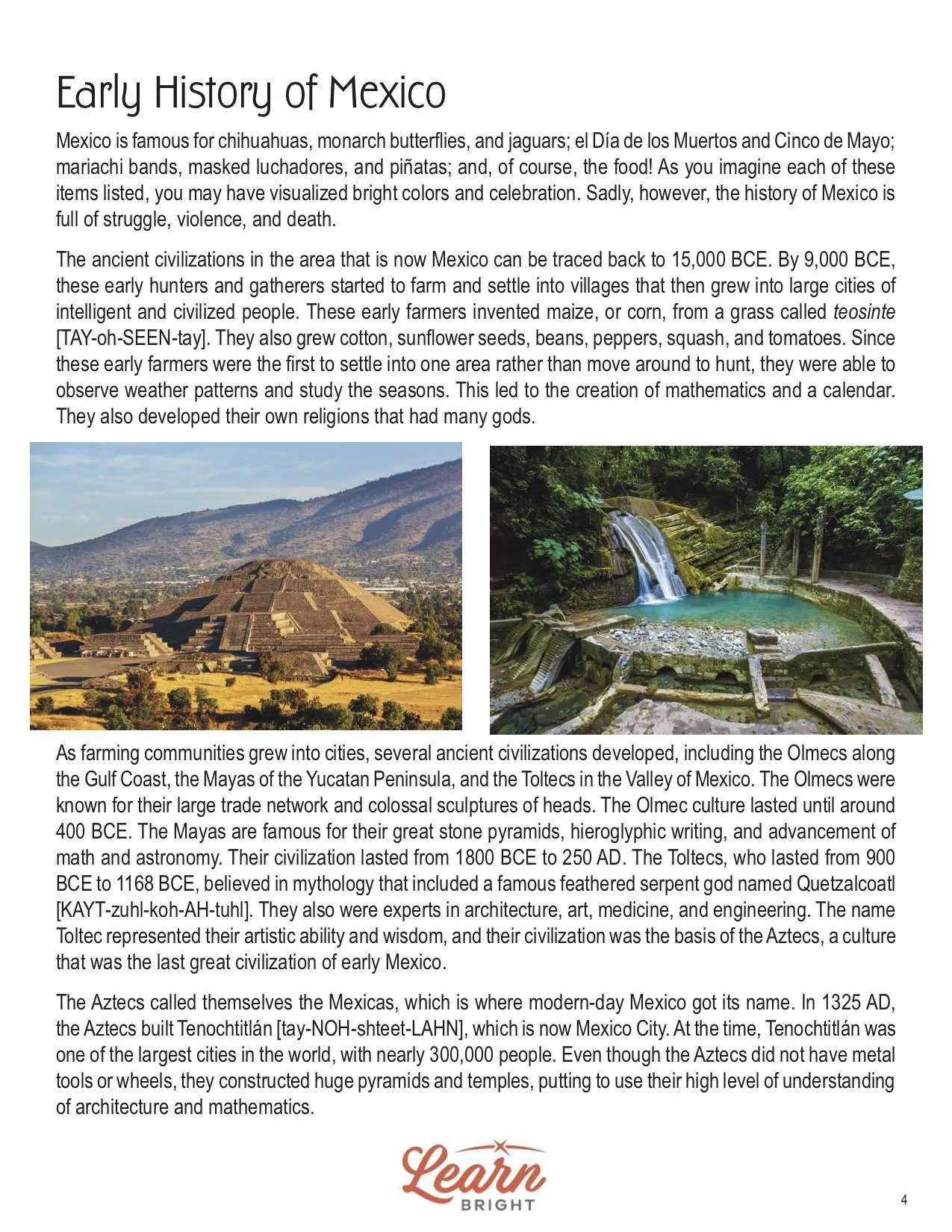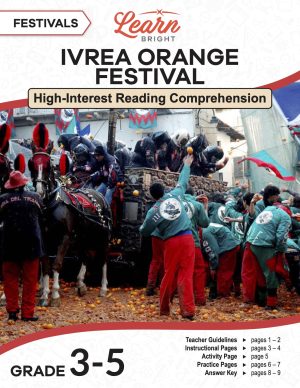Description
What our History of Mexico lesson plan includes
Lesson Objectives and Overview: History of Mexico teaches students about the colonization of Mexico and many important events and people. Students will discover many cool facts about this beautiful country. They will also become familiar with many historical figures and important events that influenced the country. This lesson is for students in 4th grade, 5th grade, and 6th grade.
Classroom Procedure
Every lesson plan provides you with a classroom procedure page that outlines a step-by-step guide to follow. You do not have to follow the guide exactly. The guide helps you organize the lesson and details when to hand out worksheets. It also lists information in the yellow box that you might find useful. You will find the lesson objectives, state standards, and number of class sessions the lesson should take to complete in this area. In addition, it describes the supplies you will need as well as what and how you need to prepare beforehand. This lesson requires colored pencils or markers.
Options for Lesson
You can check out the “Options for Lesson” section of the classroom procedure page for additional suggestions for ideas and activities to incorporate into the lesson. Use the practice and homework pages as prewriting tools for essays or reports. Additionally, students may come up with some questions they would like to investigate regarding Mexico’s history. This would be a great extension activity to do, using some of the resources provided. Students may choose to write a report, create a poster, or give a presentation of their findings.
Teacher Notes
The teacher notes page provides an extra paragraph of information to help guide the lesson and remind you what to focus on. It provides some ideas on other ways to prepare for the lesson and emphasize the culture of Mexico. The blank lines on this page are available for you to write out thoughts and ideas you have as you prepare the lesson.
HISTORY OF MEXICO LESSON PLAN CONTENT PAGES
Introduction to the History of Mexico
The History of Mexico lesson plan contains four pages of content. Mexico is famous for chihuahuas, monarch butterflies, and jaguars. You may also be familiar with el Día de los Muertos and Cinco de Mayo. mariachi bands, masked luchadores, and piñatas. And, of course, the food! As you imagine each of these items, you may have visualized bright colors and celebration. Sadly, however, the history of Mexico is full of struggle, violence, and death.
Historians can trace the ancient civilizations in the area back to 15,000 BCE. By 9,000 BCE, these early hunters and gatherers started to farm and settle into villages. Those villages then grew into large cities of intelligent and civilized people. These early farmers invented maize, or corn, from a grass called teosinte [TAY-oh-SEEN-tay].
They also grew cotton, sunflower seeds, beans, peppers, squash, and tomatoes. These early farmers were the first to settle into one area rather than move around to hunt. As a result, they were able to observe weather patterns and study the seasons. This led to the creation of mathematics and a calendar. They also developed their own religions that had many gods.
Ancient Civilizations
As farming communities grew into cities, several ancient civilizations developed. These groups included the Olmecs along the Gulf Coast, the Mayas of the Yucatan Peninsula, and the Toltecs in the Valley of Mexico. The Olmecs were known for their large trade network and colossal sculptures of heads. The Olmec culture lasted until around 400 BCE. Then Mayas are famous for their great stone pyramids, hieroglyphic writing, and advancement of math and astronomy.
Their civilization lasted from 1800 BCE to 250 AD. The Toltecs, who lasted from 900 BCE to 1168 BCE, believed in mythology. Their beliefs included a famous feathered serpent god named Quetzalcoatl [KAYT-zuhl-koh-AH-tuhl]. They were also experts in architecture, art, medicine, and engineering. The name Toltec represented their artistic ability and wisdom. Their civilization was the basis of the Aztecs, a culture that was the last great civilization of early Mexico.
The Aztecs called themselves the Mexicas, which is where modern-day Mexico got its name. In 1325 AD, the Aztecs built Tenochtitlán [tay-NOH-shteet-LAHN], which is now Mexico City. At the time, Tenochtitlán was one of the largest cities in the world, with nearly 300,000 people. Even though the Aztecs did not have metal tools or wheels, they constructed huge pyramids and temples. They put to use their high level of understanding of architecture and mathematics.
Students will learn that the Aztecs were very powerful for two hundred years, until the arrival of the Spanish. Up until this time, the Spanish had been establishing colonies in other parts of North America. When Hernán Cortés [ehr-NAHN kohr-TEHZ] arrived in 1519, he brought with him horses and cannons. Aztecs had never seen either of these things. The Spanish also brought with them diseases, such as smallpox, that killed huge numbers of the natives. By 1521, Cortés won Tenochtitlán and the rest of the Aztec Empire for Spain, renaming it New Spain.
Other European Influences
Sadly, the Spanish enslaved any native people who survived the war and diseases. They gave the slaves to Spanish soldiers to work their land. These indigenous slaves taught the Spanish about corn, tomatoes, and cacao (the bean from which chocolate is made), all new crops in Europe. The Spanish brought European crops to New Spain, such as sugarcane, wheat, and rice, as well as sheep and cattle. The Spanish made their indigenous slaves practice their European religion, Catholicism.
This was the way the Spanish would justify enslavement. They claimed that without slavery and conversion to Catholicism, the natives would not go to heaven after death. The Spanish built 12,000 Catholic churches, often on top of sacred indigenous sites. They would not allow the natives to practice their own religious rituals anymore.
In addition, the Spaniards put themselves at the top of a strict social ranking system. Below them were criollos [kree-OH-yohs], people of Spanish descent born in New Spain. Below criollos were mestizos [meh-STEE-sohs], those of mixed Spanish and indigenous ancestry. Finally, at the bottom of the social ranking system were the natives and a small number of African slaves who had been brought by the Europeans.
The Spanish ruled over Mexico for three hundred years. There were four groups of people in this colony: whites, mestizos, African slaves, and indigenous people. The whites included those who were of European descent. Mestizos [meh-STEE-sohs] were of mixed European and native descent. The African slaves were those people who the Europeans brought over. Indigenous people were the natives who had survived war, disease, and slavery. The whites controlled the money and politics of New Spain, giving small privileges to mestizos. However, the African slaves and indigenous people were considered to be less than human and were denied any rights.
Wars in Mexico
One morning in 1810, a priest named Father Miguel Hidalgo [mee-GHEL ee-DAHL-goh] was to lead a church service called mass. During mass, he told the people of his village that it was time to fight for independence from Spain. The villagers marched into Guanajuato [WAHN-uh-WAH-toh], the capital city in their state, and began to fight their colonizers. They won this first battle, but Father Hidalgo was arrested and beheaded. The Mexican War of Independence lasted for eleven years, ending when they won their freedom in 1821.
Even though the people had conquered the Spaniards, the mestizos and natives still used the class system put in place by their colonizers. The rich people, mestizos, lived like royalty while the natives and those of African descent struggled to feed their families. A series of dictators, leaders who abuse their power, took control of Mexico.
The United States had gained much power and wanted several of the Mexican territories in what is today the southwestern United States. Those states involved were Texas, New Mexico, Arizona, and California. In addition, the areas the US wanted included parts of Nevada, Utah, and Colorado. In 1836, the US settlers in Texas declared it to be an independent nation. This resulted in a terrible battle in San Antonio at an old church called the Alamo. The Mexicans won the battle by killing the settlers who were fighting from inside the church.
Ten years later, in 1846, the US started the Mexican-American War, using the now-famous phrase, “Remember the Alamo!” For two years, Mexico and the US fought over Mexico’s territories. The Mexicans fought bravely but did not have access to new weapons or enough supplies. They did not win a single battle. In 1848, when the US invaded Mexico City, Mexico gave them the land. Later that same year, gold was discovered in California, adding to the wealth of the United States.
French Occupation and Revolt
Not long afterward, the French sent its army to occupy, or take control of, Mexico. The French put an Austrian prince named Maximilian in charge of Mexico. He ruled over the country from 1863 to 1867, but he was eventually killed by Mexico’s president at the time, Benito Juárez [bey-NEE-toh WAH-res]. Juárez, who was a Zapotec Indian, was the first indigenous president of Mexico and is still well respected there.
Following Juárez as president was war hero Porfirio Díaz [pohr-FEE-ree-oh DEE-ahs]. Díaz was a dictator. During his thirty years in office, he made some good changes, and some bad ones. For example, his style of power ended revolts and threats of civil war. He also improved the economy by opening steel plants and laying down 9,000 miles of railroad tracks.
However, he did not use money for education. Only 15% of the people in Mexico were able to read or sign their own names. Additionally, he only allowed 2% of farmers to own their own land. The majority of people worked for very little money on haciendas [AH-see-EHN-dahz], or large farms. The riches people in the country owned these large farms.
In 1910, the poor people of Mexico revolted, forcing Díaz to leave the country and marking the start of the Mexican Revolution. The poor fought the rich until the war ended in 1940. More than one million people died during the Mexican Revolution from fighting or from famine and disease caused by warfare. Near the end of the war, Mexico had a new president, Lázaro Cárdenas [LAH-sah-roh KAHR-day-nahz]. He wanted to improve the lives of the poor. He gave land to landless farmers and took back control of Mexican oil wells from the US and Great Britain.
Modern Times in Mexico
During World War II, Mexico played a major role in supporting the Allies, the countries that were fighting Germany and Japan. Mexico supplied oil, lead, silver, mahogany, and other raw materials to the war effort. They also had many men to join the US military. While many Americans were fighting in the war, Mexicans came the US to continue their work in order to prevent American factories from shutting down.
Shortly after the war ended, Mexico became a popular vacation spot for American, Canadian, and European tourists. Tourism became the nation’s leading source for jobs as a result. Since then, Mexico’s economy has failed to improve. More than a million people in Mexico each year become old enough to work. But there are not enough jobs or jobs that pay enough to take care of a family. This causes many Mexicans to consider crossing into the US to get a job that pays enough to support their families, who often remain in Mexico.
The last couple of decades have also seen a rise in drug smuggling, or secretly selling drugs, which is dangerous and violent. Drug smuggling mostly occurs close to the US border, where the smugglers are able to purchase American guns and also make a lot of money from American drug dealers.
HISTORY OF MEXICO LESSON PLAN WORKSHEETS
The History of Mexico lesson plan includes three worksheets: an activity worksheet, a practice worksheet, and a homework assignment. These worksheets will help students demonstrate what they learned throughout the lesson and reinforce the lesson concepts. The guide on the classroom procedure page outlines when to hand out each worksheet to your students.
WHAT DO YOU SEE ACTIVITY
The activity worksheet for this lesson will test students’ ability to think outside the box a little bit. You can decide whether students work alone or with partners or groups. Students will discuss what they see on a blank map of North America. There are no labels, so they will have to try and remember where certain things are. The idea is to have them use academic language to describe what they see based on the outline of the continent. For instance, they may be able to label the oceans correctly and even the rough borders of the United States, Canada, and Mexico. The activity should not take too long as it is introductory.
HISTORY OF MEXICO PRACTICE WORKSHEET
For the practice worksheet, students will write as many things as possible that they know about Mexico. There are two circles, one small one in one big one. They will write “The History of Mexico” as the topic in the small circle. Then they will jot down all the things they can think of about the topic. In the four corners outside the circles, they will write how they know what they know, such as through books, movies, friends, or news sources.
VENN DIAGRAM HOMEWORK ASSIGNMENT
The homework assignment requires students to use a Venn diagram to compare what they learned about the colonization of Mexico to what they already know about that of the U.S. The instructions list a few things to think about to help guide students in the right direction.
Worksheet Answer Keys
There is an answer key for the homework worksheet at the end of the History of Mexico lesson plan document. It provides a number of bullet points that students might include in their Venn diagrams. If you choose to administer the lesson pages to your students via PDF, you will need to save a new file that omits this page. Otherwise, you can simply print out the applicable pages and keep this as reference for yourself when grading assignments.









